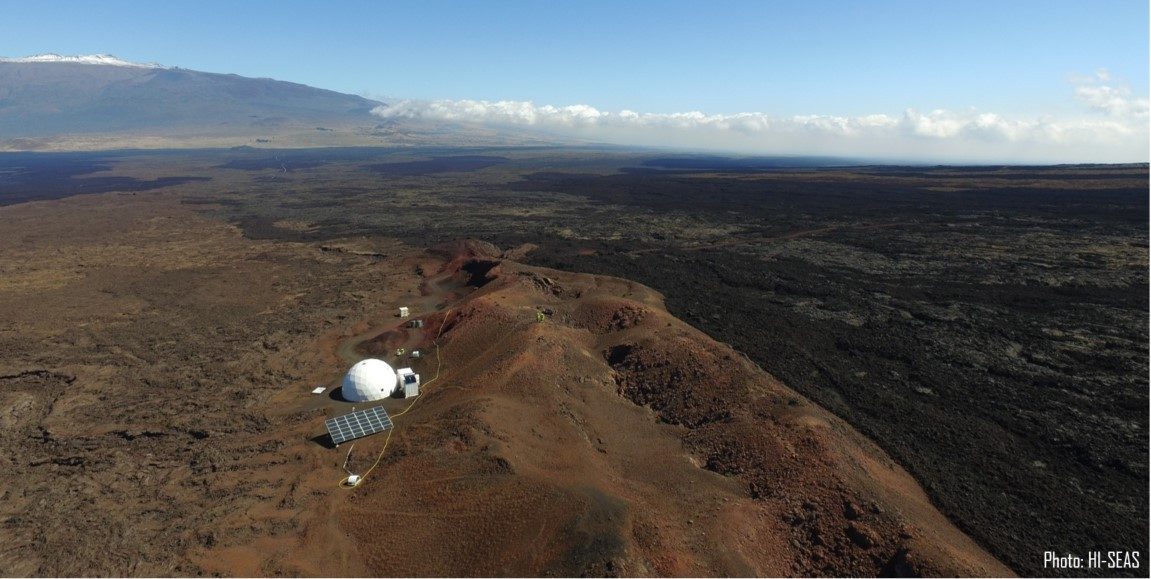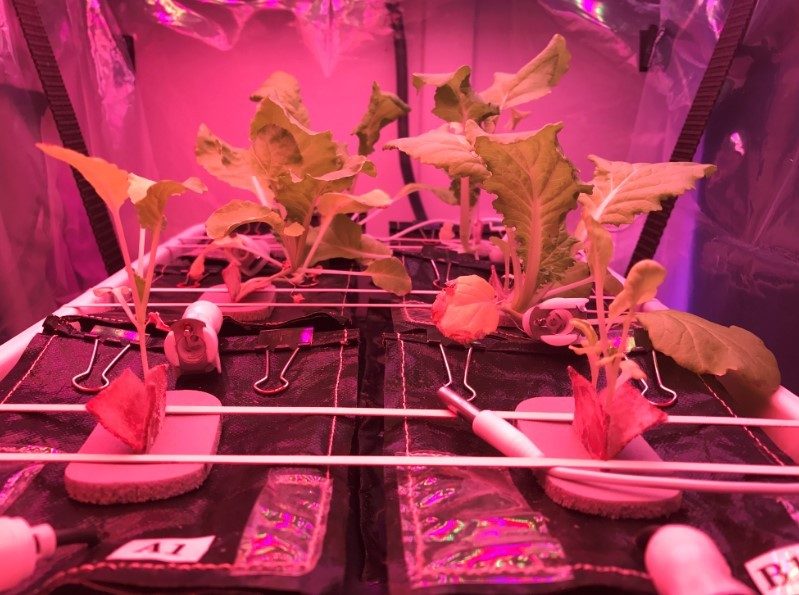The scene above appears straight out of The Martian: Mark Watney sits inside the Hab, looking out past the plants he’s been working tirelessly to cultivate. Outside the window, he watches his crewmates doing an Extravehicular Activity (EVA) across the Martian landscape.
In reality, the photo is of a place much closer to home but no less secluded: Hawaii.
Josh Ehrlich, a systems engineer working on the Orion deep space exploration vehicle out of Lockheed Martin’s Denver facility, traded in tech for a trowel as the resident botanist of the fifth Hawaii Space Exploration Analog and Simulation (HI-SEAS) study.

Against the backdrop of the arid slopes of Mauna Loa sits a habitable dome the size of an average two-bedroom apartment, in which six HI-SEAS crew members lived and worked for months on end, until the mission recently finished.
Getting humans to Mars via Orion by the 2030s is the reality at hand, and given the 6-9 month journey each way just to get there, HI-SEAS seeks to study the psychological effects of close-quarters space travel on humans.
Josh is the second Lockheed Martin employee to be selected for one of the five HI-SEAS crews. He was inside the habitat for almost eight months, and his last day inside was Sept. 17.
HI-SEAS simulates the limiting conditions of space living as best as possible. For example, water usage is metered, food – with the exception of the plants grown by Josh – is freeze-dried or dehydrated, and all outgoing messages to the outside world are put through a server that simulates the 20-minute communications delay humans will actually experience on Mars. Crew members are not even allowed to go outside without donning a spacesuit and following formal EVA protocol.

As for Josh’s role, he experimented with growing edible plants indoors under artificial light – cabbage, tomatoes and…you guessed it…potatoes. He maintains that a little green goes a long way when you’re eating dehydrated food and non-perishables day in and day out.
Josh’s work for HI-SEAS and the Orion program is critical to furthering human exploration science on both the technical and tactical sides.
Scroll down to see a video log and an exclusive Q&A with our very own Mark Watney.
Q1: What’s been your biggest challenge that you didn’t expect?
A1: You think back on what you had originally contemplated being difficult and realize after these eight months that your expectations were completely off. You figured your food selection would be limited, communications with family and friends be tied to just email, and your weekly shower time is shorter than that it takes to defrost a T-bone steak. Still, you accept those expectations and hope they aren’t as bad as you first imagined…and you were right. While the hardships and limitations faced in the habitat can be somewhat difficult, you begin to think about what you did have and appreciate them that much more. For me, it was the feeling of being outside, or lack thereof. From climbing trees as a kid to hiking mountains as a young adult, I was everywhere but inside. Even with the luxury of being in our own world here on “Mars”, segregated from the natural world around me, it was the feeling of being in that world outside of the habitat that I missed the most.
Q2: Has anything you’ve done in your career at Lockheed Martin helped prepare you for this mission?
A2: I love this type of question, not because of what I know, but what I’ve learned over the years, especially at Lockheed Martin. Before departing for HI-SEAS, I was an engineer on the European Service Module on Orion. One of the biggest learning experiences I took from that time was working with our partners at the European Space Agency and Airbus-Safran Launchers. This unique opportunity allowed me to work with some of the top engineers in Europe. What was so unique, you ask? Problem-solving methodologies and culture vary in comparison to how we conduct business in the U.S. Getting the chance to see our European counterparts approach challenges and create solutions falls nothing short of my mission at HI-SEAS. The team spans many different backgrounds, experiences, cultures and many locations across the globe. Having the motivation, open-mindedness and appreciation for witnessing others approach scenarios from a different angle helped me grow both technically and socially in preparation for the mission.
Q3: How does the project simulate the psychological stress of an actual mission to Mars?
A3: HI-SEAS Mission V was focused on the psychological understanding of both individual and team effectiveness, functionality, interaction and communication in an isolated, confined and extreme environment. There are many factors at play when it comes to living, working and interacting in the same location over an extended period of time. While the HI-SEAS study does not purposely inject stressors into the mission, the research team does analyze the planning, execution and reporting for how we complete the tasks that have been prioritized to us. The psychological behavior in response to those assignments is studied as well. On this mission, you know you’re still grounded on Earth, tens of miles away from humanity, versus the billions that would really be in play on an actual mission. In the event a crew member feels claustrophobic in an EVA suit, they have the option to break simulation for a breath of fresh air. Your psyche would definitely change in the event that same scenario occurs on Mars. Oh, and that whole “One third Earth’s gravity” thing…yeah, that alone would change your mindset when having to cook, exercise and sleep in that environment for months, possibly years on end.
Q4: Expectation vs. reality: How did your actual experience on this mission compare with what you expected?
A4: It’s quite difficult to compare every little detail of the reality of the mission with what you expected the outcome to be before arriving. Did I expect dehydrated salmon to create a taste bud revolution beyond anything one could imagine? Hardly. But the glass-half-full approach to this is appreciating what you didn’t have and cherishing it when you did: that’s what kept me locked in and looking forward to heading back to Earth. You can’t expect what you’ll miss until it’s truly gone. I’m not just talking by choice, but simply not even in the realm of possibility here on Mars. Going outside, your reality is wearing a spacesuit. There’s not shortcut around that, no second option or backup plan. The harsh environment outside the habitat forced us to adapt to what life would really be like on Mars. You have to accept your reality and treat it entirely separate from what you’re used to. If there’s one thing I didn’t expect to miss so much, it was nature. Hearing the birds chirping, feeling the wind on your skin, or getting a chance to be outside without looking through a visor, you can’t expect those effects until you’re inserted into that environment and left to memory what that sensation felt like some time ago.
Q5: Would you do this again, why or why not?
A5: Asking me this question now is liking asking a first-time marathon runner if they’d do it again right when they pass the finish line. Honestly, I absolutely would do it again. I’ve actually already been considering applying for additional terrestrial analogs during my time at HI-SEAS. A lot goes into participating in a mission such as HI-SEAS, where you are literally separated from the many comforts of home and your loved ones for a long period of time. Future missions to Mars and beyond will not encompass the same groups of astronauts from those Mercury Seven we all know and admire. “The right stuff” today isn’t defined by how many flight hours you have, the number of aircraft you’ve flown or the countless doctoral degrees you possess. That’s all great, don’t get me wrong, but future astronauts that will head beyond Earth’s orbit will need to be able to cope with the physical and psychological tolls that will come with space travel – a single, roundtrip mission alone can span over several years. The faces you will see on a daily basis are going to be the same ones you share a living space with; everyone else will be broadcasted through a screen. Your life and those you share it with will change forever. I took on HI-SEAS to learn about life and its many challenges we face when in isolation. It was a challenge both to better myself as an engineer, but more importantly as a person – to learn about teamwork, understand how to cope with stress in a technical-based environment and resolve conflict in a limited physical space.
Would I do this again? Absolutely! Only the next time, I hope I’m en route to the real Mars.
Want to learn more about Josh’s experience? Follow along with his Twitter account.




